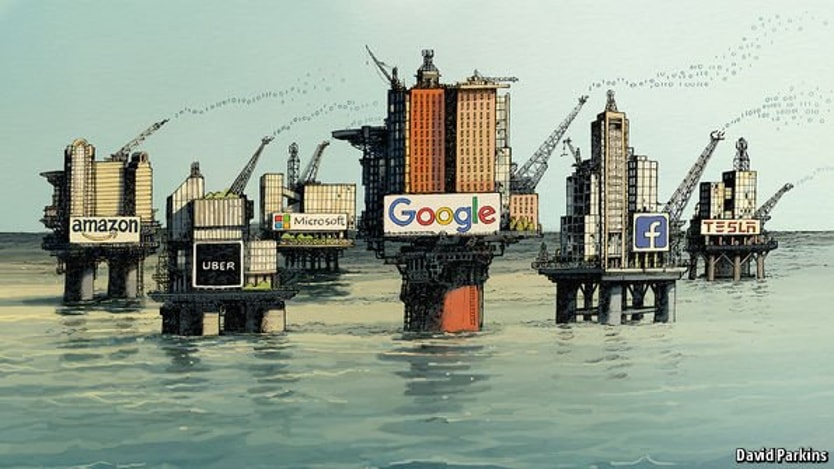This is a commentary on the article To Share or Not to Share: The Future of Collaborative Forecasting, Foresight 2022, Q4, by Pierre Pinson, Editor in Chief of The International Journal of Forecasting.
Asymmetry of Data Ownership
In Pierre Pinson’s article “To Share or Not to Share: The Future of Collaborative Forecasting,” the comparison between data and big oil is striking. Just like oil, data is not evenly distributed among geographies and owners. Few companies, in even fewer countries, own or have access to most of the consumer data generated in this world.
In the digital winner-take-all markets, we have two mobile operating systems, owned by two companies: Apple and Google. Google has a 90%+ share in online search. In E-commerce, retail sales are dominated by Amazon, with a U.S. share of 57% in 2021. Worldwide digital advertising revenue is shared among a handful of companies.
What do these businesses have in common? They use a data-centric business model, and they are the first point of contact to a consumer in the supply chain. They have access to user data from billions of people, who create more and more personal data every day.
Similar to big oil, data ownership is distributed asymmetrically across the supply chain. OPEC has controlled oil output for decades for their own good. It should be no surprise the digital giants focus on data monetization rather than data altruism. As with big oil, the digital giants go a long way to protect their data and business model.
COLLABORATIVE PLANNING, FORECASTING, AND REPLENISHMENT
We have considerable supply-chain experience with distributed data through Collaborative Planning, Forecasting & Replenishment (CPFR), which has been around since the 1990s as a process developed to reduce supply-chain costs among partners in a single supply chain.
The best application of CPFR I’ve encountered was in 2005, when working for a meat manufacturer that received point-of-sale (POS) data four times a day (10am, noon, 2pm, 4pm) from over 600 stores from the largest retailer in the Netherlands. POS data shared in the morning was used to forecast remaining meat demand for the day, and the afternoon production schedule could be adapted. POS data from the afternoon sales was used to adapt the production schedule for the next day. The meat manufacturer could only react on such short notice because of the POS data from the retailer. It was a win-win situation.
This collaboration made business sense, but it seems to be more an exception than the rule. Although there are reports that CPFR has improved financial and operational performance (Hill and colleagues, 2018), I don’t believe CPFR lives up to its potential. One of the reasons is that data in the supply chain is distributed asymmetrically towards the retailer, who has the first point of contact with the customer and owns most of the valuable consumer data.
In Australia, manufacturers can get access to POS scan sales from the largest retailers – but it comes at a cost. The retailer monetizes that data. On top of this, manufacturers can purchase data from market-data aggregators like Nielsen and Aztec, who make selling data and insights their core business
DATA SUPPLIERS
Recently, data-centric businesses like Fourkites and Project44 have been growing at a very fast pace. They have a global network that provides supplychain data from ocean freight forwarders and transporters, that they then make available for integration with your own business. It is a great way to use data and create supplychain visibility.
Although it can be used for short-term forecasting, it is not collaboration. Collaboration from data altruism could happen for several reasons: when power distribution among collaborators is equal; when sharing only small or old datasets; for trials or training, research, charities, or social good; or when there is a strong shared purpose or existential threat among the collaborators.
I see an example of altruistic data sharing for research purposes. Since 2016 there is even an agreed FAIR (findable, accessibility, interoperability and reusability) data code.
The Boston Consulting Group discusses data sharing arrangements for sustainable development and other societal challenges.
TomTom freely publicizes traffic con[1]gestion and emissions data for 50 cities around the world. https://www.tomtom.com/traffic-index/
In August, the European Parliament approved new rules boosting intra-EU data sharing to promote data altruism in support of research and health care and to fight climate change.
“Citizen sensing” crowd sources–from digital sensors of urban climates – allow individuals to collect data for the purpose of fact-finding and policymaking.
CONCLUSION
Theoretically, there should be a Nash equilibrium that would make businesses share data to achieve mutual gains. However, if we want to use large datasets for forecasting and analysis that feed into real-life business strategies and commercial business decisions in a competitive environment, we had better get used to the notion that we have to pay for it.
You can find my Foresight article here
Photo credit: The Economist. https://www.economist.com/leaders/2017/05/06/the-worlds-most-valuable-resource-is-no-longer-oil-but-data


Great article seeing how data sharing is limited within regions and industries.